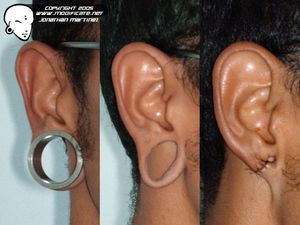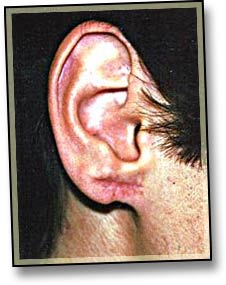|
|
| Line 1: |
Line 1: |
| [[File:Lobe.jpg|thumb|right|142px|]]
| | If you stretch your lobe past an inch or so, or you tear it, and then decide that you'd like to go "back to normal," surgical intervention will be required. As with all cosmetic surgery, a general rule is the more you spend the better a job you'll get. |
|
| |
|
| '''Earlobe piercing''' and [[Earlobe stretching]] is perhaps history's most common piercing.
| | There are some piercers willing to do this procedure for clients, but realistically this is a job for a surgeon. It should also be noted that done in a non-surgical environment there may be bleeding risks that can not be adequately handled. |
|
| |
|
| __TOC__
| | After the procedure a small linear scar will usually be left. This scar will reduce over several months, and CO2 laser resurfacing can all but eliminate any scar. |
|
| |
|
| == Placement ==
| | The reconstructed earlobe can be re-pierced and even stretched again if desired. |
| The typical placement for an earlobe piercing is directly in the center of the lobe and can vary from one earring to multiple earrings. | |
| Earlobe piercings other than directly "across" the lobe include lengthwise [[Transverse lobe piercing|transverse lobe piercings]] as well as [[Vertical lobe piercing|vertical lobe piercings]].
| |
|
| |
|
| == Procedure == | | <center> |
| The procedure for this varies from culture to culture, and also depends on the size of the initial piercing.
| | {| class="wikitable" |
| | |- |
| | | [[File:Earlobe_Reconstruction-1.jpg|thumb|left|226x285px| ]] |
| | | [[File:LobeReductionCollage1ByJonathanMartinez.jpg|thumb|left|300x225px|Lobe Reduction by Jonathan Martinez ]] |
| | |} |
| | </center> |
|
| |
|
| == Healing and Aftercare ==
| |
| The earlobe is a relatively fast part of the body to heal, usually taking 6-10 weeks, with problems being very rare.
| |
|
| |
|
| == Long-term Health Issues == | | == See Also == |
| There are no apparent health issues involved with standard ear piercings. Cartilage piercings are more prone to problems, as cartilage is a different tissue and so doesn't heal in the same way. The most common problem is the appearance of small lumps which form around the piercing. These usually occur as a result of irritation or damage to the piercing caused by careless insertion of jewelry or accidental knocks.
| | * [[Earlobe Removal]] |
| | * [[Earlobe Reconstruction History]] |
|
| |
|
| == Jewelry == | | == Entries related to this risk == |
| * [[Ear Piercing Stud]]
| | * [[Stretched Earlobe Piercing]] |
| * [[Captive Bead Ring]]
| |
| * [[Circular Barbell]]
| |
| * [[Plug]]
| |
| * [[Eyelet]]
| |
| | |
| == History and culture ==
| |
| [[Paul King]] writes,
| |
| | |
| : "When the first earlobe was pierced, we will never know. We know that the earlobe piercing certainly predates some of the earliest known civilizations such as Sumeria, Assyria, and Babylonia (Mesopotamia) from approximately 3500 BCE (or 6000 years ago).
| |
| : We also know that ancient cultures have practiced earlobe piercing on every continent and in practically every culture since the beginnings of civilization — the Mesopotamians, Mesoamericans, Africans, [[Aboriginal Australians]], Nordic, and Dongson cultures all pierced their ears. From ancient sculptures we know that multiple ear piercings were practiced in Mesopotamian, Mesoamerican, and Roman cultures. People all over the world, seemingly isolated from each other, all felt the compulsion to perforate their earlobes, usually as a way of adorning and beautifying the body, occasionally as a way of displaying wealth, status, or rank, and sometimes as a part of religious practices. Though the earlobe piercing is frequently taken from granted and not considered to be 'body modification', this body piercing more than all others has flourished over time in spite of occasional cultural prejudice.
| |
| : In Western cultures, British seamen began or popularized the man's earring. Different myths tell of [[sailors]] piercing their ears when crossing the equator, the date line (the 180th meridian), their ship sinks, or just for the hell of it to look like an 'old salt'. Romantic folklore tells us that if a couple each wear an earring from a pair then they'll never be separated.
| |
| : Traditional cultures have incorporated ear piercing into religious ceremonies for rights of passage, such as birth, puberty, circumcision, engagement, or marriage. In Eastern Europe an old wive's tale says a gold ring strengthens eyesight and wards off rheumatism. Twelve days after birth in some [[Hindu]] communities, at the name giving ceremony, a stud or small ring is inserted into the ears and nostril. In male children they are given a girl's nostril ring. The piercing is believed to distract evil spirits, making a male child look like a female and confusing the spirit. For 19th century Omaha [[Native American]]s, ear piercing was a costly ceremony; each hole representing a gift of a horse to the man who did the piercing — thankfully the price of piercing has come down a bit!"
| |
| | |
| In Biblical times ear piercings were common and usually represented ownership or slavery (i.e. the masters pierced their slaves). However, when a slave was freed from a benevolent master, some times they would choose to stay — in order to symbolically make this contract, they would have their ear pierced in court:
| |
| | |
| : ''If the servant plainly says, "I love my master, my wife, and my children: I will not go out free," then his master shall bring him to the judges. He shall also bring him to the door, or the door post, and his master shall pierce his ear with an awl, and he shall serve him forever.'' — Exodus 21:5-6
| |
| | |
| Because of that, many modern Christians choose to pierce their own ears to symbolize their surrender to their own master (i.e. servitude to God). Deuteronomy 15 comments further on this practice. Ear piercing is further mentioned throughout the Bible. For example, when the Israelites fought the Ishmaelites, Gideon told his warriors that they could take the golden earrings of the enemies they slew (Judges 8:24), and numerous passages mention the piercings of the Israelites as well (Exodus 32:3, Ezekiel 16:12, Isaiah 3:21, and so on). [[Nostril piercing]] is also common in the Bible.
| |
| | |
| == See also ==
| |
| * [[Christianity]] | |
| * [[Piercing Gun]]
| |
| * [[Earlobe Stretching]]
| |
| * [[Ear]]
| |
If you stretch your lobe past an inch or so, or you tear it, and then decide that you'd like to go "back to normal," surgical intervention will be required. As with all cosmetic surgery, a general rule is the more you spend the better a job you'll get.
There are some piercers willing to do this procedure for clients, but realistically this is a job for a surgeon. It should also be noted that done in a non-surgical environment there may be bleeding risks that can not be adequately handled.
After the procedure a small linear scar will usually be left. This scar will reduce over several months, and CO2 laser resurfacing can all but eliminate any scar.
The reconstructed earlobe can be re-pierced and even stretched again if desired.
|
|
 Lobe Reduction by Jonathan Martinez |
See Also
Entries related to this risk

